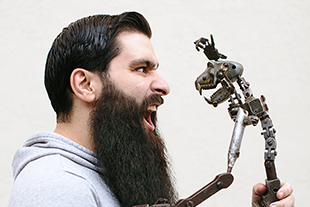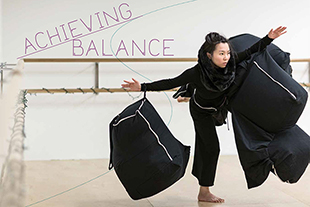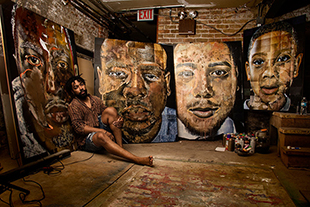Achieving Balance
DEMO Feature
Creative Arts Therapies alumnae use the body-mind connection to teach and heal.
“You know how when you dance in your living room, you feel good?” asks Julie Brannen MA ’13, CERT ’13. “We start there.”
That’s the five-second “elevator speech” she gives when she talks about her work. Brannen is a dance/ movement therapist, teacher, and dancer who trained at Columbia College Chicago. “We all have a body, and that body carries our memories and our experiences,” she says.
Columbia offers a number of majors and programs in Creative Arts Therapies, including an MA in Dance/ Movement Therapy and Counseling (DMT) and a Graduate Laban Certificate in Movement Analysis (GLMA). Columbia is one of only a handful of schools in the US to offer master’s-level DMT and Laban training.
We talked to Brannen and two other alumnae, Wei-Chiung "Coco" Chen-Martinez MA ’14, CERT ’15 and Andrea Cerniglia CERT ’15—all of whom have performed together in Cerniglia’s dance company dropshift—about their creative paths, therapeutic dance parties, and self-care in uncertain times.
DEMO: What does Dance/Movement Therapy offer to your patients and clients?
CHEN-MARTINEZ: DMT tells us that our emotions are revealed through how we present ourselves physically. When we are able to connect mind and body … we are able to interact with the world using our authentic selves.
BRANNEN: We move and dance instead [of only talking]. We do have a traditional counseling background as well. I use three main words: connection, expression, and growth. Connection to your body brings you into the present moment, because your body can only exist in the now. Expression is the emotional regulation that comes with that—our bodies are the holders of our emotions. Growth is the shift that happens.
DEMO: What is Laban Movement Analysis (LMA)?
CERNIGLIA: Laban [based on the work of early 20th-century Hungarian dance theorist Rudolf Laban] is a taxonomy of vocabulary that allows us to describe the body in a nonjudgmental way. The language is very neutral—even if you don’t have a certification in LMA, you can understand what it means. I’m not a dance/movement therapist, but I use Laban Analysis in my pedagogy. In my professional company, it’s a tool that allows me to watch dancers, assess how they use their bodies, and offer them new ways of moving.
CHEN-MARTINEZ: Laban’s language is very straightforward. When I’m performing or creating new work, it helps me clarify and describe movement. Without it, we really don’t have a common language. We only have very abstract descriptions. It’s difficult to objectively describe [movement], but if I use Laban’s terms, others understand what I’m talking about, instead of relying on my subjective descriptions.
JULIE BRANNEN

Julie Brannen is a creative arts therapist at Glenkirk in Northbrook, Illinois, a facility for adults with intellectual disabilities which provides residential and day services and employment. She is also a dance/movement therapist at the Institute for Therapy through the Arts and a teaching artist with several organizations including Hubbard Street Dance Chicago. “I always knew dance was my joy,” she says. “But there was this other part of me that really wanted to help people and go into the healthcare field.” Brannen earned a bachelor’s degree in Dance at the University of Florida, where she got involved in a “dance in medicine” program and began leading a therapeutic movement class for people with Parkinson’s disease. “I had heard of art therapy, but I had never heard of DMT until someone mentioned it to me. I looked it up and I thought, this is it. I just knew. I didn’t hold back. I went straight from undergrad into grad school.”
DEMO: What does a dance/movement therapy session look like?
CHEN-MARTINEZ: In the therapy room, it’s always different. I treat different ages, mental and physical abilities, and disabilities. I observe how people move, how their bodies present themselves while they talk about specific stories.
Sometimes we just have a dance party. It brings out a lot of joy, a lot of connection between people, a lot of positive memories. But a dance party is not just dance—there’s a lot of intervention. I use a lot of symbolism, especially in group. I once had a patient who was very isolated. He refused to talk or even eat for a month. But in the group, he [opened up] and started talking and said he wanted to be a chef. The dance party then became a “cooking” dance. It was all gesture. We were “preparing” food, “chopping” along to music … and at the end he was “serving” his food to everyone, using his hands to put it on our invisible plates. The dance fostered his connection with others.
BRANNEN: At Glenkirk, I’m working with individuals with intellectual and developmental disabilities. They’re adults, so they’re learning to create meaning in their lives. On a typical day, I see individual clients for half-hour sessions. We warm up our bodies, move body parts. It’s a lot of sensory integration. Many of them are nonverbal or have disabilities like being deaf or blind, or they’re in wheelchairs. We might be just playing with a scarf. I have one client who can only move her left hand, so sometimes I engage in therapeutic touch to orient her to the rest of her body. I try to help [my clients] move in a different way than how they would normally move. Then there’s some sort of closure … I ask them to notice if there is a shift—do you feel different now than you did when you came in?
Through the Institute for Therapy through the Arts, I’m working with at-risk and traumatized youth in a residential program, doing more of what I think of as the “classic” style of DMT. One client is a dancer and so we’re really “moving” through her stories, using her strength to kind of tap into memories and emotions around her past. But there’s a whole range of what DMT can be. It could just be simply noticing your breath. It could be laying on the floor, noticing the weight of your body.
ANDREA CERNIGLIA

Andrea Cerniglia is the founder and artistic director of dropshift dance, which she launched in 2009. She describes it as a “collaborative and investigative studio practice pushing the boundaries of the art form in performance.” Her ongoing Imposter series is an exploration of the audience/performer relationship. “I’m always trying to drive my process to a different place so it doesn’t become too static,” she says. “For myself, but also so I can create an innovative experience for audience members. We’ve been around long enough that people know that when they come to see a dropshift show it won’t be a run-of-the-mill thing.” Cerniglia is also a faculty member at Dovetail Dance Studio and Zephyr Dance Ensemble. “Teaching is something I find really exhilarating, and the GLMA certification was just another way to add to my practice,” she says.
DEMO: What is kinesthetic learning, and how do you teach with dance?
CERNIGLIA: I do arts-integrated work within the Chicago Public Schools. Working with the curriculum, I figure out a way to “move” that material. Movement can be applied to anything. Math is a really good partner for movement. One time I did a unit where the kids were working on fractions, and I had them form a giant circle. They were dancing on the circle and I held up signage that directed them: for example, do a three-quarter turn, clockwise, hopping on one leg, and they would have to figure out where they were going to go.
DEMO: Why did you choose Columbia, and how did your experience help propel your career?
BRANNEN: They did a very good job of preparing us for the field, in terms of equally emphasizing us as both clinicians and artists. For me, art is what brings us into the field in the first place … and then we learn how to heal with it … through a lot of experiential learning and pushing us to our edges to help us grow.
CHEN-MARTINEZ: I was looking for a creative place where I could continue dancing. I was an international student, so I needed a more diverse environment. I think Columbia has really solid training. The faculty are really open and supportive. The program was very intense for me, perhaps because English is my third language, but there was a lot of self-reflection.
CERNIGLIA: The [Laban] program is really supportive and adaptive. They have [younger] students that are just finishing the DMT program, but they also have people like myself who are doing just the certification program who are working professionals. The curriculum is taught in a way that’s compact … so it’s manageable for all kinds of demographics.
DEMO: Tell us about your creative practice and your experience working with dropshift dance.
CERNIGLIA: My company dropshift is an experimental modern company. Mostly the work is multidisciplinary. I work with visual artists who incorporate projected elements of film, set elements, original costume design, and original musical compositions. It’s like a laboratory for collaborating artists to come together and have a dialogue. Something that is central to my work is an exploration of the audience-performer relationship. [We’re] pushing past the traditional norms of dance where you show up at a specific time and sit in a specific place. That’s not what I do. A lot of times the performance space is melded with the viewing space … More of a gallery-type setting, much in the way that you’d view an art show.
WEI-CHIUNG “COCO” CHEN-MARTINEZ

Wei-Chiung "Coco" Chen-Martinez works with a wide range of patients at Linden Oaks, an inpatient psychiatric hospital housed at Edward Hospital in Naperville, Illinois. She also serves as a therapist at Live Oak and as vice president of the Illinois Chapter of the American Dance Therapy Association. Chen-Martinez’s master’s thesis explored the effects of dance/movement therapy on short-term memory in adults with traumatic brain injuries. At the American Dance Therapy Annual conference in 2014, she presented her research in collaboration with five dancers. Their movements synchronized with her speech, serving as a sort of human PowerPoint-slash-postmodern dance performance. “They embodied clients with brain injuries as well as the processes of working memory systems,” she says. “I don’t really like PowerPoint because I think it gets people into what we call a ‘remote state’ in Laban language. People just stare at the screen but they’re not there, not listening.”
BRANNEN: I have always seen art as the base of what I do, and it’s always been really important to me to keep the practice alive. Whether it’s yoga or dance, body-based practice has always been vital for me. I’ve always actively been part of either a company or a creative process. Some of my highlights have definitely been with dropshift. I danced with them for three years. I got the sense of what it truly means to be part of a very professional company, put on a multidisciplinary performance, and really collaborate with other artists.
CHEN-MARTINEZ: [Performing] often really synchronizes with my life. One day, working in the hospital, I created an intervention for my patients—to dance their [psychological] journey between two points in the room, one being the present moment and the other being the point in their lives they wanted to show us. One person dropped to the floor and crawled to express being beat up by illness. A few days later I had a rehearsal with dropshift and Andrea had us reflect on our own journeys over the past ten years—what we have improved and what we’ve left behind. I was like, wow—I just used this as an intervention and then it came up in my life.
DEMO: Has your own creative work or your clinical practice changed due to America’s polarized political climate? What is the role of the arts and creative therapy in this new era?
CHEN-MARTINEZ: So far, I haven’t noticed any impact on my work as a dancer. However, the political climate has absolutely influenced my clients’ sense of safety, which impacts my work as a dance/movement therapist and psychotherapist. The topics in my therapy room often include race and sexuality, especially my transgender clients who are concerned about their rights. I focus on building a sense of safety in the body through movement and guide clients to explore their strengths from their multiple (racial, sexual, and immigrant/first-generation) identities.
BRANNEN: I consider myself a healer and a helper, and I am noticing all the pain that’s coming up. It feels like the veil is being lifted on all the darkness in the world. I have to remember that I only have control of myself and stay rooted in my practice, in order to be available for whatever is to come. The arts in general transcend [news and politics]. They are absolutely important and always have been. If you feel powerless, what else do you have but your art and your voice? That’s how you express, heal, and connect to things larger than you.
CERNIGLIA: I feel exactly the same way I’ve always felt about the arts. That there needs to be support and infrastructure for artists. The arts have infinite possibilities no matter what our communities are dealing with.
DEMO: Any advice for prospective students or recent graduates who want to pursue a career in dance performance, teaching, or therapy?
CHEN-MARTINEZ: Be open and brave, be willing to work on your own personal, deep issues. Without that process it would be very hard to “hold space” for other people in the future. The process [of training in DMT] is really difficult and we tend to criticize ourselves, thinking we’re not good enough. We must learn to be gentle with ourselves. It’s ultimately a gift we offer to our clients and our patients.
CERNIGLIA: I always encourage my young students who are interested in dancing professionally. The only way you can find out if it’s the right path for you is to go through it. If you feel compelled, you should do it. Just like any other career, you learn as you go.
BRANNEN: Don’t be held back by feelings of inadequacy. Take care of yourself first. I read [Shel Silverstein’s] The Missing Piece to my clients all the time. You have to be whole and roll on your own. Give yourself space to discover that.
ONLINE EXCLUSIVE: Creative Arts Therapies student Sarah Moore finished her thesis work in Nairobi, Kenya.
Read her story at colum.edu/demo.











